Submitted by WA Contents
The poetic architecture of Luis Barragán and Lina Bo Bardi
United Kingdom Architecture News - Apr 08, 2014 - 11:03 3269 views
‘There is something strange about this house: a sense of religion, asceticism – and perhaps of obsession’
Cuadra San Cristóbal stables outside Mexico City
My house is my refuge,” wrote Luis Barragán; “an emotional piece of architecture, not a cold piece of convenience.”
A direct challenge to Le Corbusier’s contention that “a house is a machine for living in”, Barragán (1902-88) offered a poetic view of the home as a retreat. His highly individual house in Mexico City, built in 1948, is a minimal masterpiece and curiously monastic. He was intensely religious and an obsessive reader of theological and philosophical texts, and his house embraced layers of public-ness. Some rooms are expansive and generous; the most private ones small and spartan.
Inspired by north African houses, Barragán’s house presents a blank face to the street: just a solid white wall and a small door with a sliding panel – the kind of feature you might find at the entrance to a nunnery. Its entrance hall is modest but its combination of geometric simplicity, flush surfaces, rough plaster and a floor of dark volcanic stone offer an idea of a house luxurious in its attention to detail yet ascetic in its architecture.
There is, however, a flash of colour that draws the visitor in: a canary-yellow door leading to a bright pink room. Where Le Corbusier and his modernist contemporaries might have used the odd colour highlight – typically red, yellow or blue – Barragán was renowned for soaking his houses in bold, unforgettable colour.
Luis Barragán in the 1960s
Take his most photographed work, the San Cristóbal stables outside Mexico City. For its vivid blast of pinks and fuchsias set against the bright blue Mexican sky (and its reflection in the pool), the stables are a powerful Latin American riposte to the notion that modernism had to be anaemically white and allergic to colour.
A tour through Barragán’s house reveals layers in which the more public parts of the house are gradually stripped away to reveal the sparse rooms inhabited by the architect himself, and intended only for him. Each room features some nod to Christian art, ritual or iconography.
In the guest bedroom, a Madonna is placed not directly above the bed (Barragán was sensitive to those who might not share his beliefs) but to one side, her eyes turned towards her infant son – a Madonna not dominant yet still keeping an eye on the spiritual wellbeing of the guest.
Barragán House, 1948
The small, unassuming dining room reserved for Barragán alone (as opposed to the more public dining space) is among the most intense. A simple relief crucifix sits oddly to one side of the door frame. A low serving table is placed before it so that when the tray is picked up from it, the server automatically bows before the cross and then, in going through the door, passes beneath it so that the food is symbolically blessed.
Elsewhere, a gilded angel is illuminated from above; and, in one of the house’s most striking images, a window shutter is divided into quarters so that when its sections are left slightly open, the powerful Mexican sun penetrates the interior in the shape of a cross. Japanese architect Tadao Ando was apparently inspired by this image to create his Church of the Light (Ibaraki, Japan, 1989) in which the end wall is quartered to create a cross of light.
The vestibule and staircase
The most beautiful room in Barragán’s house is the high-ceilinged living room, in which the architect has carved out separate areas to create both public and more intimate private sections. Part of the wall here is composed entirely of glass and gives a wide-angle view of the gorgeous green garden so that the trees appear to be almost growing into the room and the boundary between interior and exterior seems to dissolve.
If this is the most beautiful space, the most surprising is on the roof: a terrace awash with Bárragan’s characteristic palette of colours, an abstract landscape of planes and sculptural volume but devoid of any signs of comfort. There are no plants, furniture or places to sit. There is something strange about this house: a sense of religion, asceticism – and perhaps of obsession that is at once moving and unsettling. It is a place to inspire but not necessarily a place anyone else might want to live.....Continue Reading
> via FT




